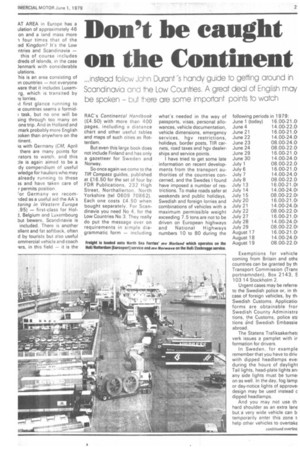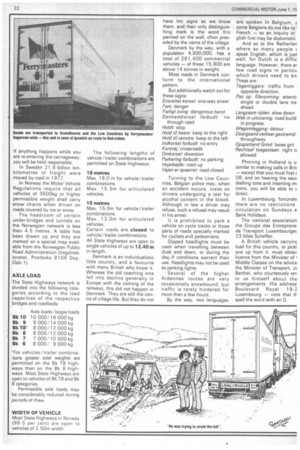Don't be caught on the Continent
Page 23

Page 24

If you've noticed an error in this article please click here to report it so we can fix it.
winstead follow John Durant's handy guide to getting around in Scandinavia anc the Low Countries. A great deal of English may be spoken but nere are some important points to watch
AT AREA in Europe has a ulation of approximately 46 on and a land mass more -I four times that of the ted Kingdom? It's the Low ntries and Scandinavia — this of course includes dreds of islands, in the case )enmark with considerable ulations.
'his is an area consisting of :n countries — not everyone mare that it includes Luxemrg, which is transited by iy lorries.
kt first glance running to Ha countries seems a formidtask, but no one will be sing through too many on one trip. And in Holland and 'mark probably more English )oken than anywhere on the itinent.
ks with Germany (CM, April there are many points for Tators to watch, and this le is again aimed to be a dy compendium of useful wiedge for hauliers who may already running to these as and have taken care of r permits position.
'or Germany we recom-Tied as a useful aid the AA's toting in Western Europe .95) — first-class for Holt Belgium and Luxembourg but beware, Scandinavia is included. There is another anent and fat softback, often d by tourists but also useful
RAC's Continental Handbook (£4.50) with more than 400 pages, including a distance chart and other useful tables and maps of such cities as Rotterdam.
But even this large book does not include Finland and has only a gazetteer for Sweden and Norway.
Sconce again we come to the T1R Compass guides, published at £16.50 for the set of four by FDR Publications, 232 High Street, Northallerton, North Yorkshire (tel 0609 70862). Each one costs £4.50 when bought separately. For Scandinavia you need No 4, for the Low Countries No 3. They really do put the message over on requirements in simple diagrammatic form — including what's needed in the way of passports, visas, personal allowances, vehicle documentation, vehicle dimensions, emergency services, hgv restrictions, holidays, border posts, TIR carnets, road taxes and hgv dealerships and service points.
I have tried to get some late information on recent developments from the transport authorities of the countries concerned, and the Swedes I found have imposed a number of restrictions. To make roads safer at weekends and public holidays, Swedish and foreign lorries and combinations of vehicles with a maximum permissible weight exceeding 7.5 tons are not to be driven on European highways and National Highways numbers 10 to 80 during the Exemptions for vehicle coming from Britain and othe countries can be granted by th Transport Commission (Tram. portnamnden), Box 2143, S 103 14 Stockholm 2.
Urgent cases may be referrei to the Swedish police or, in th case of foreign vehicles, by thl Swedish Customs. Applicatio forms are obtainable fror Swedish County Administra tions, the Customs, police stE tions j'nd Swedish Embassie abroad.
The Statens TrafiksakerhetE verk issues a pamplet with ir formation for drivers.
In Sweden, for example remember that you have to driv with dipped headlamps evel during the hours of daylight Tail lights, head-plate lights an any side lights must be turn& on as well. In the day, fog lamp or day-notice lights of approve' design may be used instead c dipped headlamps.
And you may not use th hard shoulder as an extra lane but a very wide vehicle can b temporarily enter this zone t help other vehicles to overtake If anything happens while you are re-entering the carriageway, you will be held responsible.
In Sweden 21.9 billion tonkilometres of freight were moved by road in 1977.
In Norway the Motor Vehicle Regulations require that all vehicles of 3500kg or higher permissible weight shall carry snow chains when driven on roads covered by ice or snow.
The headroom of certain under-bridges and tunnels on the Norwegian network is less than 4.5 metres. A table has been drawn up and they are marked on a special map available from the Norwegian Public Road Administration (Vegdirektoratet, Postboks 8109 Dep, Oslo 1).
AXLE LOAD The State Highways network is divided into the following categories according to the load capacities of the respective bridges and roadbeds: "For vehicles/trailer combinations greater total weights are permitted on the Bk T8 highways than on the Bk 8 highways. Most. State Highways are open to vehicles of Bk T8 and Bk 8 categories.
Permissible axle loads may be considerably reduced during periods of thaw.
WIDTH OF VEHICLE Most State Highways in Norway (98.5 per cent) are open to vehicles of 2.50m width. Max. 18.0 m for vehicle/trailer combinations.
Max. 15.5m for articulated vehicles.
15 metres The following lengths of vehicle/trailer combinations are permitted on State Highways: 18 metres Max. 15.0m for vehicle/trailer combinations.
Max. 13.0m for articulated vehicles.
Certain roads are closed to vehicle/trailer combinations. All State Highways are open to single vehicles of up to 12.40 m in length.
Denmark is an individualistic little country, and a favourite with many British who know it. Whereas the old coaching inns fell into decline generally in Europe with the coming of the railways, this did not happen in Denmark. They are still the centre of village life. But they do not have inn signs as we know them, and their only distinguishing mark is the word Kro painted on the wall, often preceded by the name of the village.
Denmark by the way, with a population 4,900,000, has a total of 261,400 commercial vehicles — of these 15,900 are above 14 tonnes in weight.
Most roads in Denmark conform to the international pattern.
But additionally watch out for these signs: Ensrettet korsel: one-way street Fare: danger Farligt sving: dangerous bend Gennemkorsel forbudt: no through road Holdt: stop Hold til hoere: keep to the right Hold til venstre: keep to the left lndkorsel forbudt: no entry Korsvej: crossroads Omkorsel: diversion Parkering forbudt: no parking Vejarbejde: road up Vejen er spaerret: road closed Turning to the Low Countries, Belgian police may, when an accident occurs, insist on drivers undergoing a test for alcohol content in the blood. Although in law a driver may refuse, such a refusal may result in his arrest.
It is prohibited to park a vehicle on cycle tracks or those parts of roads specially marked for cyclists and pedestrians.
Dipped headlights must be used when travelling between dusk and dawn, or during the day; if conditions warrant their use. Headlights may not be used as parking lights.
Several of the higher Ardennes routes are very occasionally snowbound, but traffic is rarely hindered for more than a few hours.
By the way, two languages are spoken in Belgium, E some Belgians do not like to1 French — so an inquiry in glish first may be diplomatic.
And so to the Netherlan where so many people c speak English, which is just well, for Dutch is a diffic language. However, there ar few road signs in particu which drivers need to kn These are: Tegenliggers: traffic from • opposite direction.
Pas op: filevorming: attenti, single or double lane tra• ahead Lan gzaam rijden: slow down Wek in uitvcering: road build in progress.
Wegomlegging: detour Doorgaand verkeer gestremd: throughway Opspattend Grind: loose grit Rechtsaf toegeslaan: right ti allowed Phoning in Holland is v, similar to making calls in Brit — except that you must first c 09, and on hearing the secc dialling tone and inserting mi coins, you will be able to c direct.
In Luxembourg, fortunatE there are no restrictions circulation on Sundays a Bank Holidays.
The national association the Groupe des Entreprenel de Transport Luxembourgec 23 Allee Scheffer.
A British vehicle carryinc load for this country, or picki one up from it, must obtair licence from the Minister of 1 Middle Classes on the advice the Minister of Transport, Jc Berthel, who courteously wri to us himself about the arrangements. His address Boulevard Royal 19-2 Luxembourg — note that spell the word with an 0.












































































































